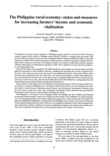The Philippine rural economy: status and measures for increasing farmers' income and economic vitalization
JIRCAS international symposium series
| ISSN | 13406108 |
|---|---|
| 書誌レコードID(総合目録DB) | AA1100908X |

本文フルテキスト
intlsymp-11_31-41.pdf457.63 KB
The agriculture sector is a major contributor to Philippine economic growth. It accounts for 20% of the gross domestic product (GDP) valued at Philippine pesos (PHP)197.7 billion at constant prices and posted 3.9% growth in 2001 (the industry and service sector contributed PHP336.7 billion and PHP454.8 billion to the GDP, respectively}. While 47% of its total land area of 13 million hectares is devoted to agriculture and about half of its labor force is employed in the sector, the Philippines remains a net importer of agricultural products, posting a USD794 million balance of trade deficit in agriculture in 2001. This is attributed to the slow growth in productivity of the agricultural sector.
Given that 50 million of its population of 79 million people are predominantly in rural areas, about two-thirds depend on agriculture for their livelihood. Moreover, considering the prevailing slow growth of productivity in the sector, much needs to be done in the rural sector if sustainable development is to be pursued. Efforts should not be focused on agriculture alone, but a link needs to be made between production and the value-adding activities characterizing the non-farm sector. In the same manner, development efforts should focus not only on rural areas but on urban areas as well, given the much-talked-about rural-urban dichotomy-presupposing that rural industrialization must go hand-in-hand with agricultural development.
The government is still hopeful about the vitalization of the agricultural sector. In fact, the present administration's thrust is to make the Philippines the 'food basket' of East Asia by 2025; a not so far fetched vision, given the country's natural resource endowment, tropical climate, and technological developments. However, much has to be done to achieve this vision. How sustainable development through agriculture and agro-industrial development is best achieved is a big challenge confronting the country.
The Philippines is not lacking in terms of program thrusts and strategies that aim to enhance agro-industrial development, increase farmers' income, and revitalize the rural economy. This is reflected in its various programs, such as modernizing agriculture and creating a million jobs, among others, which are discussed in this paper. The paper also highlights the impediments to development of the Philippine rural economy as seen from the perspective of donor groups and the government itself. These serve as a backdrop for assessment of how well the program strategies adopted have actually contributed to the goal of sustainable development and addressed the identified problems of low productivity, increasing poverty, and associated problems of the country's rural economy.
Given that 50 million of its population of 79 million people are predominantly in rural areas, about two-thirds depend on agriculture for their livelihood. Moreover, considering the prevailing slow growth of productivity in the sector, much needs to be done in the rural sector if sustainable development is to be pursued. Efforts should not be focused on agriculture alone, but a link needs to be made between production and the value-adding activities characterizing the non-farm sector. In the same manner, development efforts should focus not only on rural areas but on urban areas as well, given the much-talked-about rural-urban dichotomy-presupposing that rural industrialization must go hand-in-hand with agricultural development.
The government is still hopeful about the vitalization of the agricultural sector. In fact, the present administration's thrust is to make the Philippines the 'food basket' of East Asia by 2025; a not so far fetched vision, given the country's natural resource endowment, tropical climate, and technological developments. However, much has to be done to achieve this vision. How sustainable development through agriculture and agro-industrial development is best achieved is a big challenge confronting the country.
The Philippines is not lacking in terms of program thrusts and strategies that aim to enhance agro-industrial development, increase farmers' income, and revitalize the rural economy. This is reflected in its various programs, such as modernizing agriculture and creating a million jobs, among others, which are discussed in this paper. The paper also highlights the impediments to development of the Philippine rural economy as seen from the perspective of donor groups and the government itself. These serve as a backdrop for assessment of how well the program strategies adopted have actually contributed to the goal of sustainable development and addressed the identified problems of low productivity, increasing poverty, and associated problems of the country's rural economy.
| 作成者 | Nerlita M. Manalili Hadji C. Jalotjot |
|---|---|
| 公開者 | Japan International Research Center for Agricultural Sciences |
| オンライン掲載日 | |
| 号 | 11 |
| 開始ページ | 31 |
| 終了ページ | 41 |
| 言語 | eng |
